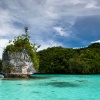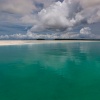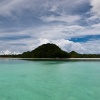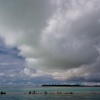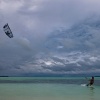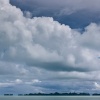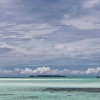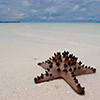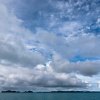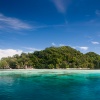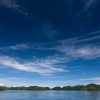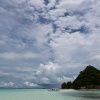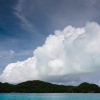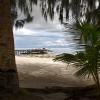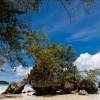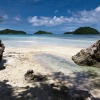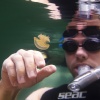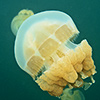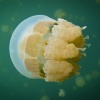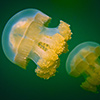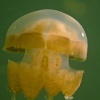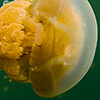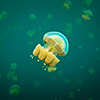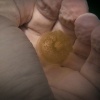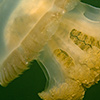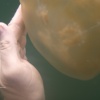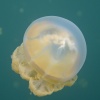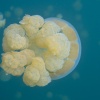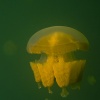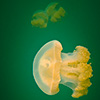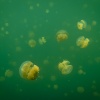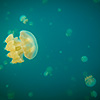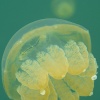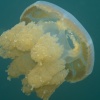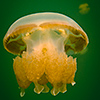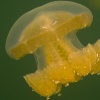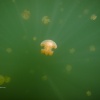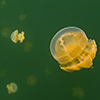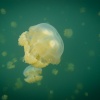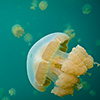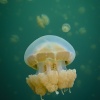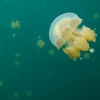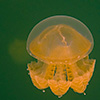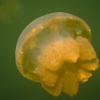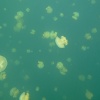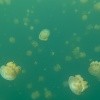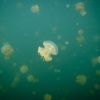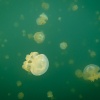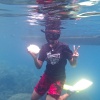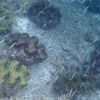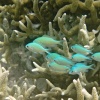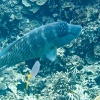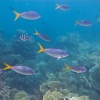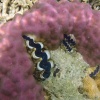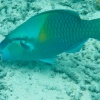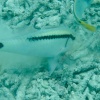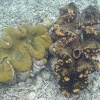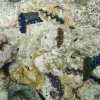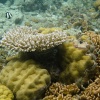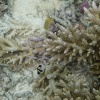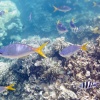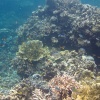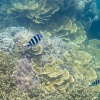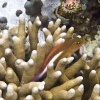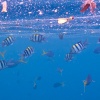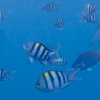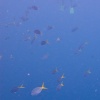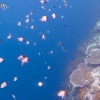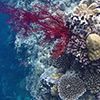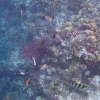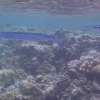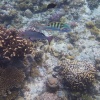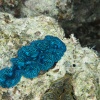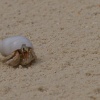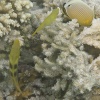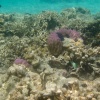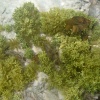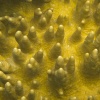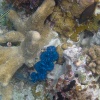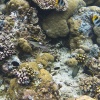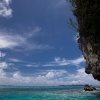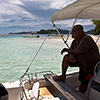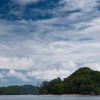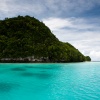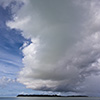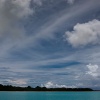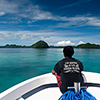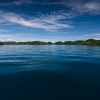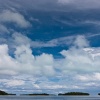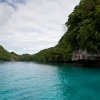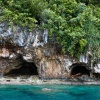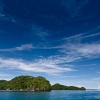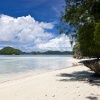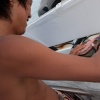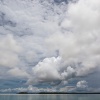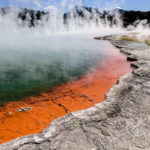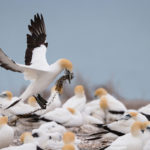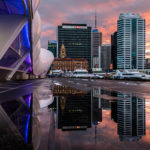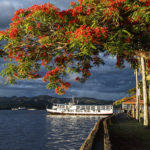Giant Clams and Golden Jellyfish – Palau
The islands of Palau are an archipelago being located some 1500km to the east of the Philippines. Several thousand years ago a tectonic uplifting process elevated its 356 islands literally to the second storey making them now looking like as if a sloppy painter was at work somewhere amidst the turquoise waters of the Pacific Ocean and left dozens of green patches behind. The rock islands of Palau are forming a large lagoon housing a worldwide unique variety of submarine life. Doesn’t matter if going below the waterline by snorkel or scuba, unavoidably you’ll become eyewitness of toilet sized giant clams, sharks en masse and countless fish being painted in all possible colours. Palau’s most amazing miracle of nature is a small stand-alone pond full of thousands of golden jellyfish drifting around in time with the shining sun at the Jellyfish Lake.
After having passed five obtuse security checks at Manila airport, where the very same things got checked again and again, the next evil called Continental Airlines already came up since beside a very late landing passengers were favoured with the by far worst food of my whole travel career. Having landed on Koror airport it is pretty surprising though that immigration as well as customs officers are very friendly even if the clock already points at 2:00 in the night. The night after such a late landing is short. To avoid oversleeping the first day in paradise, wild cockatoos and their nerve-racking loud croaking are taking care that tourists don’t miss the 6:00 o’clock mark.
“Actually there are always boats going out” says my host Lazzarena and takes a load off my mind. Then she got the idea to introduce me to a Chinese family from Guangzhou since they chartered a boat and could be happy to share costs. Within seconds we had a deal and minutes later our small speed boat was already heading southwards along the eastern lagoon boundary. Prior to departure visitors must have obtained a permission though. The permit for Jellyfish Lake and Rock Islands costs 35 US$ and gets quickly issued. Once the small plastic card is in one’s hands the boat ride can start.
To the beat of our two 150 PS engines we’re chasing over the waves towards Eil Malk island, the Y-shaped main island of the Mecherchar island group. Unbelievable but true during the past 3 weeks it was raining almost 24/7 and not much sunlight was fondling Palau’s enchanted rock islands. Also this morning it’s not really sunny, but in case of a visit to the Jellyfish Lakes (![]() ) that can become an advantage though. Photographically seen missing light isn’t a real corker and photos might look a bit cheerless, on the other hand then the tennis ball sized animals are coming much closer to the surface to catch more sunlight, hence you don’t have to dive down as you’re in the thick of things and can see much more than on sunnier days.
) that can become an advantage though. Photographically seen missing light isn’t a real corker and photos might look a bit cheerless, on the other hand then the tennis ball sized animals are coming much closer to the surface to catch more sunlight, hence you don’t have to dive down as you’re in the thick of things and can see much more than on sunnier days.
The jellyfish are living in symbiosis with algae that logically only can start photosynthesis if there’s sufficient sunlight available. The animals are rising to the surface if light conditions are tame, then snorkelers get surrounded by dozens of jellyfish and they become hundreds when staring into the watery distance of the lake. The light being reflected by the jellyfish chute looks wonderful and depending on the actual sunlight it is changing from yellow to orange. Same applies to the lake that sometimes appears in a cold turquoise blue but then changes to a surreally glowing saturated green.
Avidly the eyes are absorbing all impressions and your head turns around every second anew to follow a different jellyfish. Some of them are lazily floating from A to B, some other seems to be in a hurry. Palau has a couple of such-like lakes but there is only one open to the public. Surprisingly the less salty lake is colder at the surface than deep down. The rising temperature in the depth as well as fresh water intrusion is proof that the lake has a hidden gateway to the open sea and that it is also fed by fresh water sources. The mingling of fresh and salt water produces moments were all things called optical cognition become pretty fuzzy.
Palau’s Jellyfish Lake is a stand-alone eco system hence it is very important to protect it from unnecessary contamination. Peeing from the pool edge is as forbidden as back home and putting on sun screen before entering the lake is a no go as well. A t-shirt or diving suit is doing the same job and protects perfectly from the ever blazing sun. Scuba diving is not allowed at the lake and if you’re lucky you can enjoy the lake on your own but only if Palau’s tourism industry didn’t dump (a) boat(s) full of cluster-like moving tourists from the Far East. Touristically seen Palau is kind of spoken for Japanese-Chinese-Taiwanese hands as all of those countries are max. 5 hours flight time away.
Lunch breaks are often held at one of the countless beaches. However, all those amazing snorkelling impressions will quickly make you forgetting running time and even ravenous appetite. Inside of the lagoon parrotfish are often seen companions. They are very colourful eye-catcher but also they are eating alive corals, hence making the reefs looking odder as they’re excreting fine white coral sand, thus Palau’s inner reefs might look a bit spooky sometimes. An often made stop is the one at Milky Way Bay (
In the next days different boat tours took to different other places, without Chinese but being accompanied by Mili, my dive partner. Once again we visited the Jellyfish Lake, this time with sunlight par excellence and Mili also showed me the remaining northern as well as southern rock islands. Mili lives in Palau and knows all of its islands inside out. She introduces me renowned diving sites and wonderful places such as Long Beach, the submarine scarp face ‘Big Drop-Off’ and of course also the German Channel (![]() ). Latter one is an access channel cut into the reef by the Germans back in 1909 as for phosphate transportation purposes a connection between outer reef and Chelbacheb islands was needed. Where the usually more or less shallow German Channel gets deeper, from time to time divers can meet manta rays.
). Latter one is an access channel cut into the reef by the Germans back in 1909 as for phosphate transportation purposes a connection between outer reef and Chelbacheb islands was needed. Where the usually more or less shallow German Channel gets deeper, from time to time divers can meet manta rays.
A really impressive diving site is the Big Drop-Off (![]() ). There a submarine scarp face abruptly drops some 250 metres away. While on top of this wall really nice corals can be found, big fish are taking over control if you go down deeper. Driven by water jet nutrient matter arrive the ocean surface, which explains the run of fish and other animals; then water appears a bit more “dirty” as it is loaded with particles. Similarly spectacular is the Peleliu Drop-Off whose ocean currents are so strong that they can carry away unconcentrated divers to the Philippines, some 1500km to the west.
). There a submarine scarp face abruptly drops some 250 metres away. While on top of this wall really nice corals can be found, big fish are taking over control if you go down deeper. Driven by water jet nutrient matter arrive the ocean surface, which explains the run of fish and other animals; then water appears a bit more “dirty” as it is loaded with particles. Similarly spectacular is the Peleliu Drop-Off whose ocean currents are so strong that they can carry away unconcentrated divers to the Philippines, some 1500km to the west.
One way or the other diving in Palau means to meet superlatives easily, for example a superlative like toilet bowl sized giant clams whose velvet-like lips are shining in all possible colours. You can’t miss them when diving at the inner lagoon and their offspring is literally spread all over the entire archipelago. However getting caught by a giant clam is definitely no fun at all!
Another spectacular diving site is located at the south-western Ngemelis island group, so to say it’s just around the corner of the fine white beaches of Carp Island. Even snorklers can have a lifetime shark experience at the Blue Corner (![]() ). It is unbelievable to swim among 20 reef shark, look and even touch them. For unexperienced it is about concentration then as panic easily carries forward, hence toys like the camera should be left on board. However, that is much better as such a moment can be enjoyed much more intensive.
). It is unbelievable to swim among 20 reef shark, look and even touch them. For unexperienced it is about concentration then as panic easily carries forward, hence toys like the camera should be left on board. However, that is much better as such a moment can be enjoyed much more intensive.
A problem or better to say phenomenon being common in Palau is the mingling of water having a different salinity. You can see that in the videos when suddenly all things become fuzzy heat haze like. Filmic that is not a big problem, however photographically this will make you produce lots of scrap.
Doesn’t matter if the sun is shining and the sky is blue or if the sky is shrouded in clouds, Palau’s little rock islands always cut a fine figure. In particular that is enjoyable when being in the morning or evening hours near the Seventy Islands, a small picturesque group of islands in the west of Palau archipelago. You cannot get close though as it’s a preservation area for all things called fauna and flora.
With horizons broadening impressions the journey takes me back home, but this time even terrible Continental Airlines is not able to remove the smile from my face. Palau, a wonderful patch of earth.
